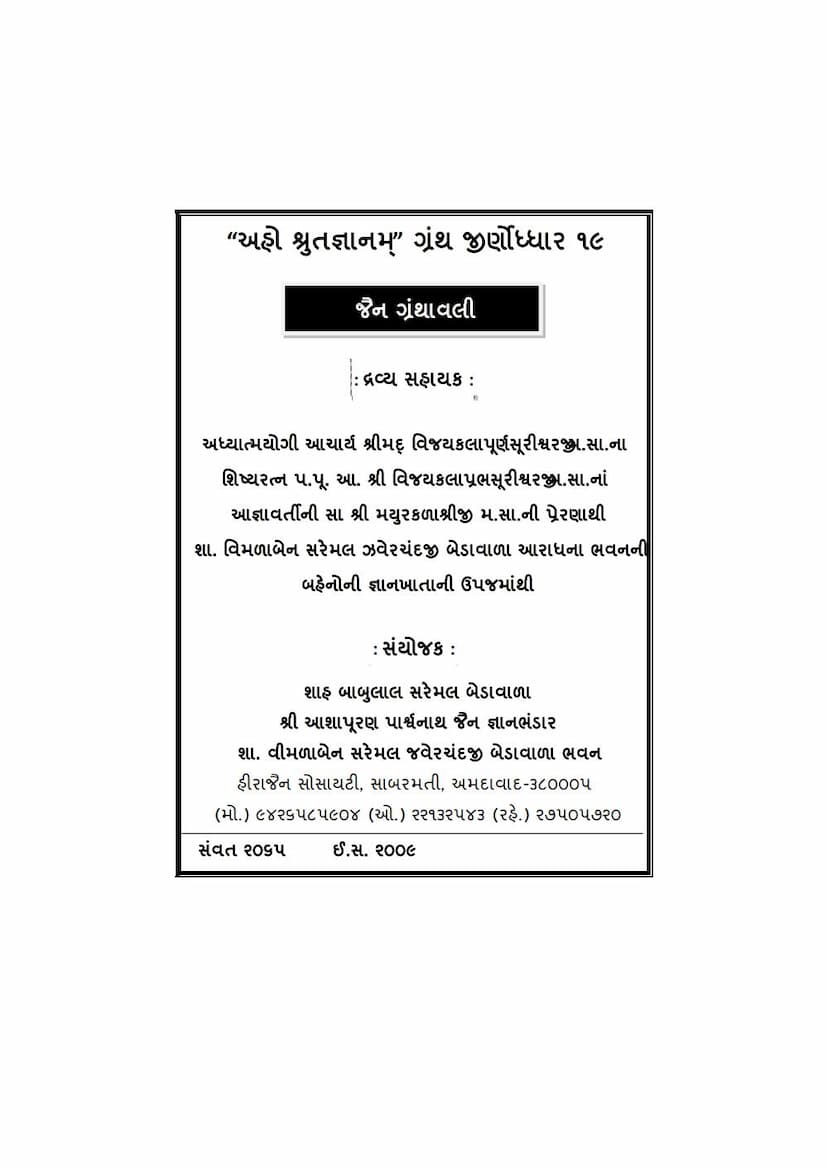Jain Granthavali
Added to library: September 2, 2025

Summary
This comprehensive summary is based on the provided Jain text, "Jain Granthavali," compiled by the Jain Shwetambar Conference, Mumbai, and published in 2009 (Samvat 2065). The text serves as a catalog or directory of Jain scriptures.
Here's a breakdown of the key information presented:
Overall Purpose: The "Jain Granthavali" is a monumental effort to document and catalog Jain literature, primarily focusing on the Agamas (scriptural texts) and related philosophical, ethical, and scientific works. It aims to provide a systematic overview of the vast and historically significant Jain literary tradition, noting the locations of manuscripts and the authors of these works.
Publisher and Sponsorship: The work is published by the Jain Shwetambar Conference, Mumbai. The preservation and dissemination of this knowledge were made possible through the generous contributions of individuals and organizations, such as the "Aradhana Bhavan" sisters' "Gyan Khata" of Vimalaben Saremal Ji Bedawala, and the inspiration from Acharya Shrimad Vijay Kalapurnasurishwarji and Acharya Shri Vijay Kalaprabhsurishwarji.
Historical Context and Motivation (From the Preface): The preface highlights the historical decline of Jain knowledge following the era of Lord Mahavir Swami. It emphasizes the challenges faced due to the passage of time, natural calamities, political upheavals, and the lack of printing technology, which led to the loss or scarcity of many ancient texts. The compilation is motivated by the need to preserve the remaining literary heritage and make it accessible. It acknowledges the efforts of figures like Surivarya Devardhiganikshamashraman Maharaj who, in Vikram Samvat 523, took the initiative to preserve knowledge by transcribing texts into written form to prevent their complete destruction. The text laments the current state where many original manuscripts are lost, and even the extant texts have undergone changes or are incomplete due to various adversimites. It stresses the importance of protecting and preserving the remaining literature and calls for continuous efforts in this regard.
Structure of the Granthavali: The Granthavali is organized into several lists, each dedicated to a specific category of Jain literature:
-
List No. 1: Jain Agama (जैनागम): This is the most extensive section, meticulously listing the various Agamas, their original texts (Mool), commentaries (Vritti), sub-commentaries (Churni, Avchurni, Deepika), authors, estimated verse counts (Shlok), and the Vikram Samvat of their composition. It also indicates the various Bhandars (libraries) where these manuscripts are available. The text discusses the classification of Agamas and the subsequent compilation efforts.
- The list includes the Angas (like Acharanga, Sutrakritanga, Sthānanga, etc.) and Upangas (like Aupapatika, Rajprashariya, etc.), along with their commentaries and details.
- It also details other important Agama texts like Samavāyānga, Bhagavati, Jñātdharma Katha, Upāsakadashā, etc.
-
List No. 2: Jain Nyaya (जैन न्याय): This section focuses on texts related to Jain logic and epistemology. It lists works on concepts like Anekāntavāda, Syādvāda, Pramāṇa, and Nyāya. The entries include information on authors, verse counts, and locations of manuscripts.
-
List No. 3: Jain Philosophy (जैन फिलॉसोफि): This broad category encompasses philosophical treatises. It is further divided into:
- Texts by prominent authors like Haribhadra Suri and Yashovijayji Upadhyay.
- Texts related to philosophical concepts, ethics, and principles of conduct.
- The list provides details of authors, verse counts, and manuscript locations.
-
List No. 4: Jain Upadesha (जैन औपदेशिक): This section covers didactic and advisory literature, including moral teachings, stories with ethical lessons, and guides for conduct. It lists various types of texts like Pravechan, Upadesha, Kathas, and Stotras.
-
List No. 5: Jain Language and Literature (जैन भाषासाहित्य): This section is dedicated to works on Jain grammar, lexicography, and literature in various Prakrit and Sanskrit dialects, including commentaries on grammatical texts.
-
List No. 6: Jain Science (जैन विज्ञान): This category includes Jain works on various branches of science, such as:
- Jyotish (Astrology/Astronomy): Texts on astrological calculations, portents, and celestial observations.
- Nimitta (Divination/Prognostication): Works dealing with omens, auspicious signs, and predictive sciences.
- Kalpana (Imagination/Creativity/Practices): Texts related to rituals, practices, and possibly creative literature.
- Mantra (Incantations/Mantras): Works focusing on the power and application of mantras.
Key Features and Information Provided for Each Entry: For each book listed, the Granthavali provides:
- Serial Number: A sequential number within each list.
- Name of the Work (नाम): The title of the scripture or text.
- Verse Count (श्लोक): An estimated number of verses or poetic lines, where applicable.
- Author (कर्ता): The name of the composer or commentator.
- Verse Count Estimate (रच्यानो): The estimated year of composition in Vikram Samvat.
- Location of Manuscripts (भंडारो): This is a crucial aspect of the catalog, indicating in which libraries or collections the manuscripts of the work can be found. The text uses abbreviations for various Bhandars (e.g., पाटण No. 1, जेसलमेर, मुंबई, डेक्कन कॉलेज).
- Remarks (रिमार्क): Any additional notes or observations about the manuscript or the work.
Importance of Bhandars: The text places significant emphasis on the various "Bhandars" (libraries) where these ancient manuscripts are preserved. Page 8 provides a detailed list of these Bhandars with their specific locations and the names of the supervising entities, highlighting the organized effort behind the collection and preservation of Jain literature.
Overall Significance: The "Jain Granthavali" is a testament to the dedication of the Jain community in preserving its rich intellectual and spiritual heritage. It serves as an invaluable resource for scholars, researchers, and anyone interested in the study of Jainism and its extensive literary tradition. The catalog reflects a systematic approach to documenting historical texts, acknowledging the challenges of their preservation, and aiming to make this knowledge widely accessible.